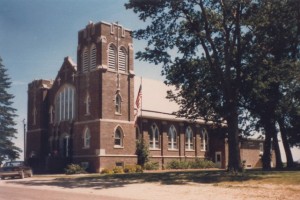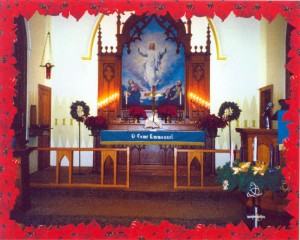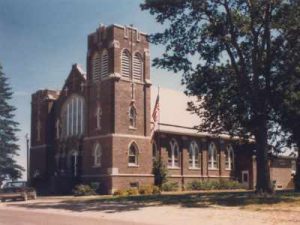From Peter Grauer[1]
My mother died in 1912. At her funeral the undertaker was Louie Nelson. He still used horses to draw the hearse. There were about 12 horses drawn buggies at the funeral and about the same number of automobiles. The cars left first and then waited at Trinity Lutheran Church for the horse drawn vehicles to arrive. My father was not used to cars and did not much care for them. He said it made him uneasy to ride in some of those early automobiles. He did not feel that he was in control because there was no tongue out in front to which horses could be hitched. Horses did not seem to like the new “contraptions”, any better than he did. Many horses would take to the ditch and even go through a fence when they met an automobile, in fact I got my ankle sprained one time when the horses became frightened by an approaching automobile and our buggy was upset in the ditch. The tongue was splintered so badly as to be useless. I used it to make my first “real flying kite”, and Boy, did it ever go high. It went up so high that it took all the slack in the string. I would send pieces of paper upon the string and could feel the jolt as the circle of paper would hit the kite.
I was married to Arta Paffle at Trinity Lutheran Church south of Marcus on August 17, 1921. We went to LeMars for the reception. It was held at the home of her parents, Mr. & Mrs. Al Paffle. Then we went on to Jefferson, Iowa spent a few days, we also took in the State Fair at Des Moines. There I saw Captain Briggs of Headquarters Company and many of my old army buddies. Most of them were from Minneapolis, Minnesota. When we came home from our wedding trip, we started up house keeping on the farm where I still live, 60 years later. My brother, Lou and his wife, Mabel moved to Marcus. He had farmed 80 acres for a while; they decided to go into a grocery store.
Arta and I began a slow upward climb from the roaring twenties to the dust bowl of the thirties; there were times when we really had to tighten our belts.
In 1923 we began building a new Trinity Lutheran Church. It was made of brick and was to be a monument to the Glory of God for letting World War I come to an end. The first Sunday after the Armistice was signed, Henry Specht pledged $ 1000 to start off a building fund. We moved the old church to the north, side of the lot, and began digging a basement. We used horses hitched to scrapers. We had to set off same sticks of dynamite to loosen the frozen ground to enable us to scrape it out. After we had finished the basement, we began to work with a contractor. Material such as brick, cement and stone came to Marcus by railroad. A committee of three men, Adam Grauer, Gerhart Hesse and Carl Doer kept track of when it would arrive and then let the farmers know as when they could come and haul it out to the building site.
The weather seemed “spotty” and changeable. It might rain hard all night so we would decide to go get the supplies while it was too wet for farm work. After eating dinner in Marcus we would start out for the church with our loads, and see the farmers around town working in the fields. We had to unload the brick at the church yard before we could go home and attend to our chores and other necessary jobs. Very often, it would rain again during the night making it impossible to get into the fields. The weeds just kept on growing. The brick and cement usually came in on time, but one time the stone failed to come so the contractor was obliged to stop work for a week. There was a “straw boss” and a mechanic who were supposed to look after things. One evening when I came in from the fields, Arta told me that the stone for the church had come. They wanted it hauled out as soon as possible. My team of horses had worked all day and were tired, so I unhitched them and took their harnesses off, after they bad been attended to, I had chores to do. Then I got another team ready and started for Marcus shortly before sundown. I had plenty of help to load the stone on the wagon from the railroad car, but by that time the sun was down and it was getting dark. There were two Model T trucks also being loaded and of course they were able to make better time. It was about 9:30 when I left Marcus that evening with a team of horses and a lumber wagon and a load of stone. I got to the church about 11:30 that night. The moon was quite bright but there was no other light and there was no one around to help me unload. It was late and I was tired after a full day’s work in the field. I sat there in the pale moon light and wondered just what I could do. Then I heard the dull rumble of a truck coming down the gravel road which is now known as C 38. I watched its lights as it came to Simson Bethel Corner, where the four way stop is now. There it slowed down and turned west. It stopped near me and sure enough, it was the Straw Boss and his mechanic. I stood up and said, “I am surely glad to see you men, where do you want this load of stone?” They said, “Just leave it set until morning, we will unload it when it is daylight”. “Nothing doing,” I said, “I will cultivating corn in the morning”. So we all pitched in and helped, and the stone was unloaded that night. I felt that I had one over on Paul Revere. He left Boston Church at midnight on a saddled horse to spread the alarm to the country side. I left Trinity Church after midnight in a lumber wagon and two weary horses. I got home about 1:30 the next morning. The truck that came to my rescue that night had no cab or windshield. The seat was a rough board with only sacks to sit on, and a 12 inch plank on either side. There also was no endgate. But the roar of that antique truck was sweeter than any music to my ears on that most eventful night. Work on the church progressed through out the spring season. The contractor was questioned about mixing the mortar for the brick on Friday. Then covering it and waiting until the following Monday to finish the job. He claimed it was a new method and would work out fine. Some 10 or 12 years later we wondered about his new method, when it costs us about $ 8000 to repaint the brick. The building committee at first decided to use the seats from the old church in the new one. Then it was decided to buy new ones but no one had any ideas as to how to pay for them. A meeting was called, one Sunday after church. We met in the parsonage, and one man sad he would donate $ 600[2] to start off with, then another offered $ 300[3], and still another $ 250[4]. The pastor got a pencil and paper to pass around so we could make our pledges. We had the $ 2500 needed to put in the new pews in less than 30 minutes. The “$ 250 I pledged” took 5 years to pay off.

The corner stone of the new church was laid on May 20, 1923. I sang in the choir on a platform when Reverend Ilten was handed a trowel to lift some mortar to put under the stone. Some soft cement splashed up on his fine pressed suit, but he did not seem to mind it. He said: “Fifty years from now when most of us will be in our graves, this church will still be standing, and someone will still be preaching the Gospel.” Reverend Wolfram, great grand father of Michael Wolfram, who is now pastor of Peace Lutheran Church in Marcus, was also on the platform. He was president of Missouri Synod of the whole Iowa District.
After the corner stone was laid, plastering and bricklaying seem to continue at quite a rapid pace. We looked forward to the completion and the dedication with much eagerness. The dedication took place on Sunday, Dec. 16, 1923.
It had cost $ 3500 and was free of all debt. Many considered Trinity Lutheran Church the most beautiful rural church in the state of Iowa. It was a small church, but had more stones used on it, than many of the larger churches in the east, it made me happy to realize that I had been responsible for hauling some of those stones, even if one load had been hauled at midnight in a lumber wagon.
The weather was beautiful on that Sunday of the dedication. When we lined up for dinner the line extended from the dining room hallway, through the basement up the stairs and out on to the sidewalk. The doors were wide open. No one felt the need for an overcoat. Adam Dorr[5], father of Fred Dorr, said: “Jesus fed the five thousand, and is still done today.”

One of the most unique features of Trinity was the slanting floor. The seats in the back were much higher than the front pews. This was very unLutheran. The ascention picture in the alter was given in memory of Mrs. Will (Hilda) Ohlendorf, Eddie’s mother.
[1] son of Christof Grauer (born 16.10.1851 in Jettenburg)
[2] Adam Grauer
[3] Carl Dorr
[4] Jeity Wilkens
[5] Lulu Grauer’s grandfather
